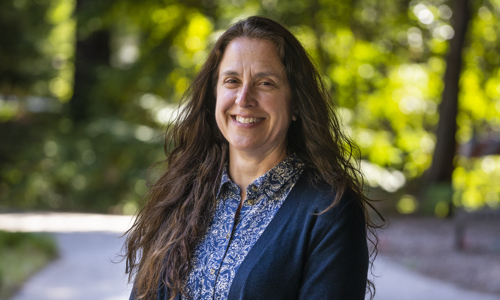One of the most anxious moments Lisa Wisser had in the COVID–19 pandemic was in March 2020 when she realized masks were in short supply.
Wisser, director of UC Santa Cruz Environmental Health and Safety, and Risk Services, was responsible for providing employees with safety equipment and was stunned that masks weren’t available for purchase. Even hospitals couldn’t get enough masks for their staff at that time.
As someone in the field for over 20 years, Wisser had participated in planning exercises for pandemics numerous times. “This was not something that our country never thought about before,” she said. “How our country could not be ready for a pandemic was shocking.”
While watching the pandemic unfold in early 2020, the EH&S team realized that face coverings were going to be essential for employees who needed to work together on campus. The team scrambled to find anything that would work, from refurbished N95 respirators to bandanas to cloth masks hand-sewn by the theater department costume shop.
At the same time, the EH&S team came together to help each of the on site “essential” groups reduce the risk of COVID spread in their work areas. They helped rearrange spaces for physical distancing and provided in person or Zoom information sessions to help employees understand how to protect themselves at work and at home. EH&S and Risk Services staff continue to provide this outreach today.
The next big hurdle was figuring out how to serve employees who wanted to keep their own work space cleaned with disinfectant. The Centers for Disease Control and Prevention recommends disinfecting frequently touched surfaces daily, such as desks and keyboards, to protect yourself against the virus.
Early on in the pandemic, EPA-approved disinfectant was also sold out. So UC Santa Cruz EH&S decided to set up its own bulk dispenser bottling operation at the brand-new EH&S facility on Heller Road. The team filled thousands of personal-use bottles with the same highly effective disinfectant used by campus custodial services. The disinfectant program was designed with sustainability in mind, as bottles can be returned for refilling rather than disposed.
A constant challenge throughout the pandemic has been staying updated with current information about the disease. Wisser followed all the main public health agencies including the CDC, the California Department of Public Health and Santa Cruz County Public Health, as well as the California Occupational Safety and Health Administration. The different agencies were not always unanimous about the best actions to take, Wisser said. As an example, the CDC recommended face coverings before the state required them.
“There were definitely different recommendations coming from different places at different times,” Wisser said. “We would always take the most protective approach at the time.”
On top of keeping up with the latest recommendations, she was part of daily UC-system wide phone calls about how to respond to the pandemic. “This is a great example of the ‘Power of 10’ concept,” she said referring to the number of UC campuses that worked together to share information.
Looking back, she said what she has learned the most from the experience is the importance of good communication. “You need to tell people what you know and what you don’t know,” she said. “You need to get back to them and say, ‘I know we talked about this last week, but the information just changed.’”
She is grateful that vaccines are now available, but she doesn’t feel close to ready to let down her guard yet.
The university is planning to get most students back on campus for classes in the fall, which will entail a lot of preparations. She and others who work in Environmental Health and Safety and Risk Services will not be getting a break for a while.
Though the advent of vaccines makes things more hopeful, there is no slowing down.
“Vaccines are a light at the end of the tunnel,” she said. “It’s a very positive moment and it definitely helps. But just because we have a vaccine, it’s not over. We’re not there yet.”



